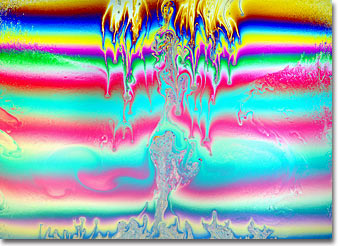Karl E. Deckart
Soap Bubble Gallery: Image Two
German photographer and artist Karl E. Deckart is known for his thorough, precise, and beautiful work both in photography through the microscope and with macro camera systems. This gallery of interference photographs made with soap films is a testament to both Deckart's skill as a photographer and his understanding of the physical phenomena that surround our everyday lives. Presented below is soap bubble image number two in small format. Click on the image to download a larger version.

|
Macrophotography of thin soap films freely suspended on a 4 x 4-inch wire frame was conducted with a Linhof large-format bellows camera system utilizing 4 x 5-inch sheet film and imaged using an apo-macro Nikon large format Nikkor-AM ED 210 mm f-5.6 lens. To prepare the soap film, equal parts of water, glycerin, and dishwasher detergent are thoroughly mixed in a container until a solution containing evenly sized micelles is achieved. A freestanding film is formed by dipping the wire frame into the solution and withdrawing carefully to maintain an even film thickness and avoid disruption of material flow across the frame rails. After suspension, the film was illuminated by a reflected light source positioned a few degrees from the camera system. The light was passed through a diffusion screen to avoid bright spots and provide an even illumination across the field. No polarizers were employed in photomacrography of soap thin films. Image ©1999 by Karl E. Deckart. All rights reserved. |
Traditionally, soaps have been made from animal fats and lye, however, use in highly mineralized hard water created an unsightly "bathtub ring." To solve this problem, inert synthetic detergents were developed. Although some of the very early detergent varieties produced a chemical reaction with acids and metal salts in hard water, the resulting insoluble complexes either slowly dissolved or floated away in a less sticky colloidal form. Many of the early detergents were derived from crude oil and eliminated much of the scum problem; however, the particles and suds did not completely break down creating environment hazards in waterways and the water supply. Development of more advanced detergents began with the discovery of linear alkylsufonates. These cleaning agents are derived from petrochemicals and can be formulated to retain favorable cleaning characteristics of earlier detergents, yet be more easily biodegradable. Other desirable cleaning properties include cold-water solubility and protein dissolving enzymatic action.
BACK TO THE SOAP BUBBLE GALLERY
